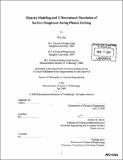| dc.contributor.advisor | Herbert H. Swain. | en_US |
| dc.contributor.author | Guo, Wei, Ph. D. Massachusetts Institute of Technology | en_US |
| dc.contributor.other | Massachusetts Institute of Technology. Dept. of Chemical Engineering. | en_US |
| dc.date.accessioned | 2009-08-26T17:01:03Z | |
| dc.date.available | 2009-08-26T17:01:03Z | |
| dc.date.copyright | 2009 | en_US |
| dc.date.issued | 2009 | en_US |
| dc.identifier.uri | http://hdl.handle.net/1721.1/46600 | |
| dc.description | Thesis (Ph. D.)--Massachusetts Institute of Technology, Dept. of Chemical Engineering, 2009. | en_US |
| dc.description | Includes bibliographical references. | en_US |
| dc.description.abstract | The control of feature profiles in directional plasma etching processes is crucial as critical dimension, line-edge roughening, and other artifacts affect device performance and process yields. A profile simulator is necessary to predictively model the etching processes as well as roughness transfer and artifact evolution. The development of profile simulators has been inhibited by the limited knowledge of the surface kinetic processes and rate coefficients. A mixing-layer surface kinetic model was developed to account for plasma-surface interactions. The simplified reaction set was carefully chosen to reflect the overall etching characteristics and the rate coefficients were fitted to experimental data. After the model was tested for accuracy using poly-Si etching in Cl2 gas plasma, it was incorporated into the 3-Dimensional (3-D) Monte Carlo profile simulator with a cell-based representation. The good match between the profile simulation and the kinetics modeling results verified the capability of incorporating complex chemical processes into the 3-D simulator. The angular dependence on etching yield was modeled based upon the mixing layer kinetics model. All the rate coefficients fitted previously at normal ion incidence were kept constant without any further optimization. The angular curves were assigned to all ion-initiated reactions based upon their characteristics and the overall etching yield was calculated with a combination of individual etching yields. The variation of etching yield with ion bombardment angle for poly-Si in Cl2 plasma was modeled and showed quantitative agreement with the experimental measurements, indicating the angular curves for all the fundamental reactions are sufficient to account for the etching behavior at off-normal angles at different operating conditions. With the modeling of angular dependence, the kinetics model is complete and can be used to explore the surface roughness in the 3-D profile simulator. The roughening of the SiO2 surface in fluorocarbon plasma was explored using the 3-D Monte Carlo profile simulator. | en_US |
| dc.description.abstract | (cont.) The kinetics of SiO2 etching in C4Fs/Ar plasma was first developed in a similar fashion to that for poly-Si etching, with the additional assumption of equal reaction rates among all ionic or neutral radicals. All the ionic and neutral species experimentally measured were taken as inputs and the etching yield were predicted over a range of neutral-to-ion flux ratios and ion energies. Angular dependence on etching yield was also modeled to take into account the etching at off-normal angles. Then the kinetics was incorporated into the 3-D simulator and a good match was found between the experimental and profile simulation results in terms of etching yield and surface composition at various conditions, suggesting the kinetics after incorporation is capable of predicting complex surface chemistry of oxide substrate with fluorocarbon plasma. Then SiO2 surface roughness was simulated as functions of ion bombardment angle and neutral-to-ion flux ratio. The surface patterns, preferential orientation with respect to the ion beam and spatial frequency of the simulated surface showed a qualitative match with the experimental observations. The transition from coarsening to smooth surface with the increase of neutral-to-ion flux ratio was captured and related to the extent of polymerization on the surface. At low neutral-to-ion flux ratio, the modeled surface composition contour confirmed the formation of polymer islands around the roughened area, leading to etching inhomogeneity on the leading and shadowing side of features. The formation of polymer patchiness according to the simulation verified the polymer-induced micro-masking mechanism people proposed mechanistically to explain roughening on dielectric films. At high neutral-to-ion flux ratio, the simulation showed a higher extent of polymerization and yet the polymer deposit fairly uniformly and result in a smooth surface. The 3-D simulator coupled with detailed kinetics provided insights to the surface roughening mechanism on a microscopic basis. | en_US |
| dc.description.statementofresponsibility | by Wei Guo. | en_US |
| dc.format.extent | 160 p. | en_US |
| dc.language.iso | eng | en_US |
| dc.publisher | Massachusetts Institute of Technology | en_US |
| dc.rights | M.I.T. theses are protected by
copyright. They may be viewed from this source for any purpose, but
reproduction or distribution in any format is prohibited without written
permission. See provided URL for inquiries about permission. | en_US |
| dc.rights.uri | http://dspace.mit.edu/handle/1721.1/7582 | en_US |
| dc.subject | Chemical Engineering. | en_US |
| dc.title | Kinetics modeling and 3-dimensional simulation of surface roughness during plasma etching | en_US |
| dc.title.alternative | Kinetics modeling and 3D simulation of surface roughness during plasma etching | en_US |
| dc.title.alternative | Kinetics modeling and three-dimensional simulation of surface roughness during plasma etching | en_US |
| dc.type | Thesis | en_US |
| dc.description.degree | Ph.D. | en_US |
| dc.contributor.department | Massachusetts Institute of Technology. Department of Chemical Engineering | |
| dc.identifier.oclc | 424651007 | en_US |
